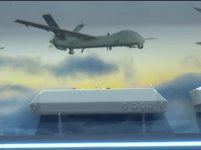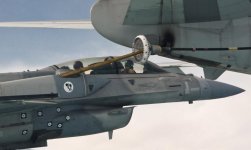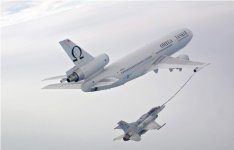Why would Tusas produce a flying wing form as Anka-3?
Main notion that lies behind that is the fact that a flying wing has parameters that imparts stealthiness.
Stealthiness is not achieved by adhering to just specific geometry or materials alone. It is the sum of all different parts of the equation that makes a plane stealthy.
A good example is Typhoon. Due to the delta wing it has inherent stealth characteristics. But it has a canard and has to carry missiles and bombs under its wings that will detract from its stealth. To compensate for that the lines are aggressively designed to keep frontal view as stealthy as possible. Then all the weapons placements are in recessed positions under the wings to keep them away from radar signals. Only 15% of the aeroplane’s body contains metal to make it harder to bounce radar signals.
“Typhoon EW suite employs a range of electronic countermeasures that allows the aircraft to digitally hide its signature, becoming invisible to radar, or to digitally create a complex and confusing picture (noise) for a threat operator, denying them a clean targeting opportunity and preventing them from launching a missile in the first place.”
Anka-3 has the major prerequisite already in place. It has the lowest achievable RCS and highest stealthiness due to the shape of the flying wing. No canards, no vertical stabilisers. Once the TF6000 engine is in situ it will have another part of the puzzle in place as well. It is mainly manufactured from stealth friendly composite materials. When ready, an Aesa radar will most likely be put in place to give it more capabilities including EW to help improve its electronic stealthiness.
Having produced KAAN and now ANKA-3, you can be rest assured that Tusas knows what it is doing. These tests with ammunition under its belly is to provide data and give them an idea about what to expect when stealth is reduced. You can’t expect this plane not to carry weapons under its wings, as @dBSPL has explained above. It will carry Super-Şimşek and a host of other bombs that may detract from its stealth. But not to such an extent that will make it impossible to use them; especially in case-specific instances, where you know what your adversary’s radar capabilities are like.
Main notion that lies behind that is the fact that a flying wing has parameters that imparts stealthiness.
Stealthiness is not achieved by adhering to just specific geometry or materials alone. It is the sum of all different parts of the equation that makes a plane stealthy.
A good example is Typhoon. Due to the delta wing it has inherent stealth characteristics. But it has a canard and has to carry missiles and bombs under its wings that will detract from its stealth. To compensate for that the lines are aggressively designed to keep frontal view as stealthy as possible. Then all the weapons placements are in recessed positions under the wings to keep them away from radar signals. Only 15% of the aeroplane’s body contains metal to make it harder to bounce radar signals.
“Typhoon EW suite employs a range of electronic countermeasures that allows the aircraft to digitally hide its signature, becoming invisible to radar, or to digitally create a complex and confusing picture (noise) for a threat operator, denying them a clean targeting opportunity and preventing them from launching a missile in the first place.”
Anka-3 has the major prerequisite already in place. It has the lowest achievable RCS and highest stealthiness due to the shape of the flying wing. No canards, no vertical stabilisers. Once the TF6000 engine is in situ it will have another part of the puzzle in place as well. It is mainly manufactured from stealth friendly composite materials. When ready, an Aesa radar will most likely be put in place to give it more capabilities including EW to help improve its electronic stealthiness.
Having produced KAAN and now ANKA-3, you can be rest assured that Tusas knows what it is doing. These tests with ammunition under its belly is to provide data and give them an idea about what to expect when stealth is reduced. You can’t expect this plane not to carry weapons under its wings, as @dBSPL has explained above. It will carry Super-Şimşek and a host of other bombs that may detract from its stealth. But not to such an extent that will make it impossible to use them; especially in case-specific instances, where you know what your adversary’s radar capabilities are like.
Last edited:










